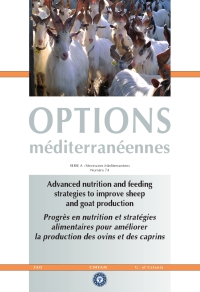| Article précédent | p. 285-290 | Article suivant |
Use of different leguminous seeds for lactating goats. Amino acid composition of the raw material and the rumen undegradable fraction
The suitability of different leguminous seeds (lupine, beans, bitter vetch and vetch) for the nutrition of goats was investigated. The ruminal degradability of the N in each protein source was estimated using the nylon bag technique. The amino acid composition of the original protein sources and of the residues in the bags after ruminal incubation was also determined. The beans had more (P<0.05) of the quickly degradable fraction of crude protein than did the other three leguminous seeds. Lupine seeds had a higher (P<0.05) rate of degradation than did the other protein sources. The lowest value for effective degradability was observed for bitter vetch. The overall change in the amino acid profile due to ruminal fermentation depended on the protein source provided. The amino acid profile of the different leguminous seeds was among them, more similar before ruminal fermentation. However, the profile of their rumen undegradable protein fractions resulted very different. When a multivariate analysis was carried out, organization of the leguminous seeds in the order of the intensity of change, yielded the following: lupine, beans, bitter vetch and vetch.
Dans cette étude a été analysée l'aptitude de l'usage de diverses légumineuses en graines (lupin, fève, ers et vesce), dans l'alimentation de la chèvre. La dégradabilité du N de chacune des sources protéiques a été réalisée au moyen de la technique du sachet en nylon. De la même façon on a déterminé la composition en acides aminés des sources originales de protéines et des résidus contenus dans le sachet. Par rapport aux trois autres légumineuses, les fèves ont présenté une fraction supérieure (P<0,05) de protéines rapidement dégradables. Le lupin, lui, face aux trois autres légumineuses, a présenté un taux de dégradation plus élevé (P<0,05). Les valeurs les plus faibles de dégradation effective ont correspondu aux ers. Le changement subi dans la composition en acides aminés dû à la fermentation de la rumination, dépendait de la source protéique. Le profil amino-acidique des différentes graines de légumineuses se trouvait être semblable avant la fermentation de la rumination. Au contraire, le profil correspondant aux fractions non dégradables par rumination, se trouvait être relativement différent. En réalisant une analyse factorielle à multiples variantes, les différentes légumineuses se sont trouvées classées selon l'intensité du changement subi dans leur composition en acides aminés, de la manière suivante : lupin, fève, ers et vesce.
- [ Afficher ]
- [ Télécharger ]
- [ Exporter la citation ]
Vous pouvez télécharger la citation au format :
- [ Imprimer ]
-
Mots-clés
ACIDE AMINE, ANALYSE STATISTIQUE, CHEVRE, DIGESTION DU RUMEN, EXPERIMENTATION, FEVE, GRAINE, LEGUMINEUSE, LUPINUS, PROTEINE, REGIME ALIMENTAIRE, VICIA SATIVACiter cet article
Ramos E., Molina Alcaide E., Yáñez Ruiz D.R., Fernández J.R., Sanz Sampelayo M.R. Use of different leguminous seeds for lactating goats. Amino acid composition of the raw material and the rumen undegradable fraction. In : Priolo A. (ed.), Biondi L. (ed.), Ben Salem H. (ed.), Morand-Fehr P. (ed.). Advanced nutrition and feeding strategies to improve sheep and goat . Zaragoza : CIHEAM, 2007. p. 285-290. (Options Méditerranéennes : Série A. Séminaires Méditerranéens; n. 74). 11. Seminar of the FAO-CIHEAM Sub-Network on Sheep and Goat Nutrition, 2005/09/08-10, Catania (Italy). http://om.ciheam.org/om/pdf/a74/00800393.pdf



